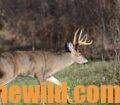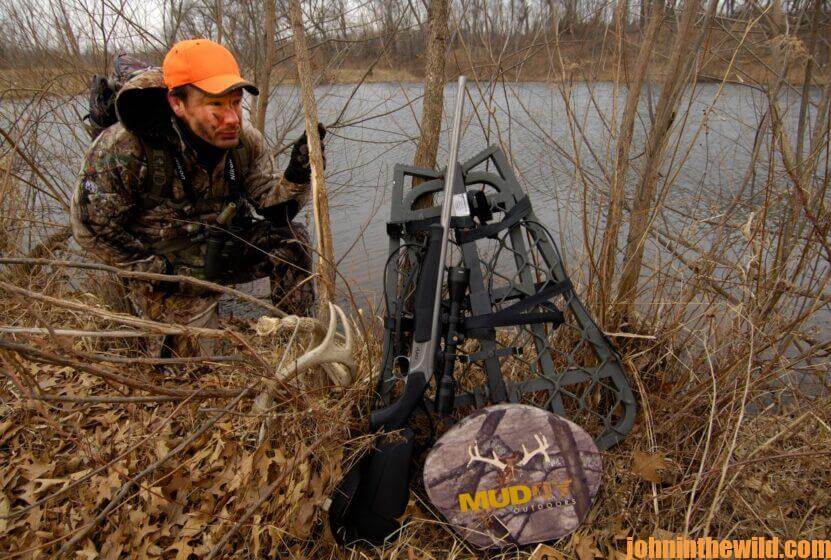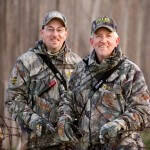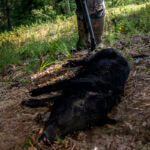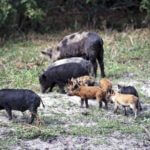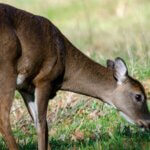Editor’s Note: Hunters can use much of the equipment they have at their homes already to make hunting deer easier on their lands, including leaf blowers, shovels, backpacks, trail cameras, rakes, ATVs and flagging tape to name some. They also need to understand how to find and take big deer on small lands near their homes.
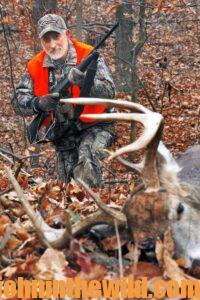
Trail cameras have become one of the deer hunter’s best friends to see where deer are moving at day and night, determine the antler sizes of the bucks and learn how many and what types of deer are moving by the cameras. You can decide which bucks you want to harvest. But you may have trouble finding a tree that’s big enough or straight enough to hold a tree stand that’s within a reasonable distance for your shooting ability to take the buck you want to harvest with your bow. However, with a lawnmower and a weed eater, like Jamie Jensen (See Day 1), you can cut a trail coming from where you enter the woods to the tree where you’ve hung your stand, walk in quietly and get into your stand quickly and silently.
Deer, much like some people I know, always want to take the easiest route from where they are to where they want to go. They prefer not to duck their heads to get under limbs and brush, don’t want their antlers clicking against tree limbs and do want to walk with their heads up to see, smell and hear better. If you brush-in the trails the deer are accustomed to walking down with limbs and sticks piled several feet high, longtime hunters have learned the deer will take the trail of least resistance, rather than walking the old trails they’ve used in the past.
Hunting Aids for Deer Hunters:
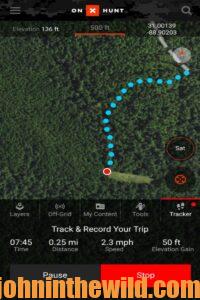 You can find places to hunt that other people aren’t hunting – especially on public lands. Many public-land maps don’t show actual property lines but instead use terrain features like creeks, rivers and roads on their maps, which are easier for hunters to identify when those maps have been made than showing actual property lines. You also can mark the trails you take to various places on these apps, and they’re not visible to other hunters. Bottlenecks, funnels, gaps in mountains and other terrain features that often produce deer can be very visible on a hunting app. Plus, you can mark trails, scrapes, rubs and bedding sites on these apps that aren’t visible. My son once discovered a productive place to hunt by identifying land that didn’t appear to be part of the hunting property, since it wasn’t adjacent to it. But his OnX App identified it, and he saw 14 deer, both does and small bucks, the first time he scouted it and knew other hunters hadn’t found it.
You can find places to hunt that other people aren’t hunting – especially on public lands. Many public-land maps don’t show actual property lines but instead use terrain features like creeks, rivers and roads on their maps, which are easier for hunters to identify when those maps have been made than showing actual property lines. You also can mark the trails you take to various places on these apps, and they’re not visible to other hunters. Bottlenecks, funnels, gaps in mountains and other terrain features that often produce deer can be very visible on a hunting app. Plus, you can mark trails, scrapes, rubs and bedding sites on these apps that aren’t visible. My son once discovered a productive place to hunt by identifying land that didn’t appear to be part of the hunting property, since it wasn’t adjacent to it. But his OnX App identified it, and he saw 14 deer, both does and small bucks, the first time he scouted it and knew other hunters hadn’t found it.
Once you’ve located a tree stand or a ground blind site to hunt, the hunting app will tell you the wind direction you need to hunt at that site. But what hunters most appreciate is being able to find their vehicles. If you’ll mark your waypoint, regardless of where you hunt, the hunting app can guide you by the shortest route back to your vehicle.
- https://mapstore.mytopo.com/ – This site is a map service. You can order maps of any property in the United States where you want to hunt. One of the great new features that My Topo has started adding to its maps are boundary lines on all the properties on the map, as well as the landowners’ names. Using several different maps, you often can find small overlooked lands to hunt that you may be able to obtain permission to hunt for free or to lease at a reasonable price. Once you choose the maps most important to you, My Topo will make these maps for you and laminate them, so you can carry them with you. More and more hunters are scouting by using these maps discover small places they can hunt for deer.
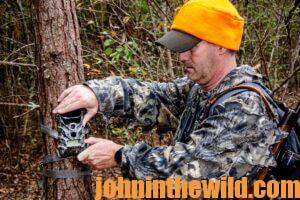
- Alabama Liquid Fertilizer – According to Chris Grantham with Alabama Liquid Fertilizer, https://www.facebook.com/ALFandSupply/ , “One of my customers sprayed our fertilizer on a green field at 10:00 am one morning, and at 2:30 pm, he harvested a nice 8-pointer there.” One of the major problems with planting green fields is that deer go to your fields primarily before daylight and after dark. However, Alabama Liquid Fertilizer has evidence that liquid fertilizer can help solve this problem. Two types of fertilizer used on green fields include: granular fertilizer that’s put in the ground before planting; and liquid fertilizer that’s sprayed on the plants themselves when a crop covers the ground.
Grantham says, “Since the liquid fertilizer is absorbed through the leaves, spraying liquid fertilizer will help your plants put on more tonnage quicker than granular will. Another advantage of liquid fertilizer is that 80-90% of the liquid fertilizer is absorbed into the plants within the first few hours of spraying and will start attracting wildlife much faster than granular fertilizer will.”
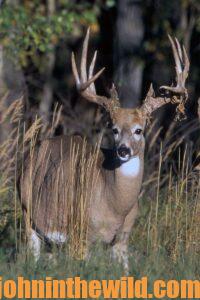 Grantham usually waits up to eight weeks before he resprays his food plot after the initial spraying of liquid fertilizer, depending on how much of the food plot has been eaten by the deer. “Liquid fertilizer will feed fall, spring and summer green fields and can be used year-round. Liquid fertilizer performs faster than granular because it’s taken in through the leaves of the plants instead of coming up from the roots. You don’t have to have a perfect soil pH or even know what the pH of the soil is before you plant. The soil’s pH doesn’t affect how much liquid fertilizer gets in the plant as it does if you use granular fertilizer on the ground. Of course, nothing replaces planting your green field in an area that has good soil with proper pH. Liquid fertilizer can enhance the nutrients in the soil, make up for the deficiencies in the soil where you plant your green fields and attract deer in the daytime and from long distances.
Grantham usually waits up to eight weeks before he resprays his food plot after the initial spraying of liquid fertilizer, depending on how much of the food plot has been eaten by the deer. “Liquid fertilizer will feed fall, spring and summer green fields and can be used year-round. Liquid fertilizer performs faster than granular because it’s taken in through the leaves of the plants instead of coming up from the roots. You don’t have to have a perfect soil pH or even know what the pH of the soil is before you plant. The soil’s pH doesn’t affect how much liquid fertilizer gets in the plant as it does if you use granular fertilizer on the ground. Of course, nothing replaces planting your green field in an area that has good soil with proper pH. Liquid fertilizer can enhance the nutrients in the soil, make up for the deficiencies in the soil where you plant your green fields and attract deer in the daytime and from long distances.
- Trail Cameras – From my research, I’ve learned that trail cameras are essential for finding big bucks on small properties before, during and after hunting season. Luckily, there’s a wide variety of trail cameras on the market today. Trail cameras reduce the number of hours you have to spend scouting. They tell you if there are big bucks on the property you want to hunt and also when and where these bucks are moving during daylight hours. The trail camera I use the most is a Stealth (https://www.stealthcam.com/). I’ve let my son use my cameras, before I start my serious scouting. He puts these the trail cameras out on a wooded lot right behind his house in suburbia. He’s discovered he has four nice bucks using a little wooded corridor that runs through the subdivision. The trail cameras there also have photographed foxes, coons, possums and a wide variety of other wildlife that my grandchildren have enjoyed seeing. With such a wide variety of trail cameras on the market today, study the trail-camera market, and pick the trail camera that suits your hunting needs the best.
John E. Phillips’ latest deer book “How to Hunt Deer Like a Pro: Volume II,” just was published on Amazon in print at https://www.amazon.com/gp/product/B0BGSP3QPB/ref=dbs_a_def_rwt_hsch_vapi_tpbk_p4_i4
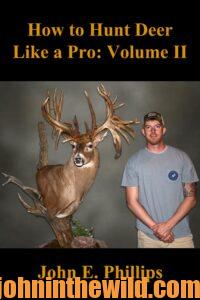 The Audible version should be available by mid-November. Since deer hunting and deer hunters are drastically changing each year, John interviewed some top deer hunters like Mark Drury, Dr. Larry Marchinton, Dr. Bob Sheppard, Pat Reeve, Gene Wensel, Cody Robbins, Ernie Calandrelli, Brian Murphy and Luke Brewster, who took the world’s largest whitetail, to learn their up-to-date techniques for successfully hunting deer and having more places to hunt. Also, John’s first book in that series “How to Hunt Deer Like a Pro” at http://amzn.to/YpoQHA for Kindle, print and Audible, includes other outstanding deer hunters. Learn even more about hunting deer by checking out John’s book, “How to Hunt Deer Up Close with Bows, Muzzleloaders and Crossbows” https://www.amazon.com/dp/B00A2A6ZG6#. You may have to copy and paste these links into your browser.
The Audible version should be available by mid-November. Since deer hunting and deer hunters are drastically changing each year, John interviewed some top deer hunters like Mark Drury, Dr. Larry Marchinton, Dr. Bob Sheppard, Pat Reeve, Gene Wensel, Cody Robbins, Ernie Calandrelli, Brian Murphy and Luke Brewster, who took the world’s largest whitetail, to learn their up-to-date techniques for successfully hunting deer and having more places to hunt. Also, John’s first book in that series “How to Hunt Deer Like a Pro” at http://amzn.to/YpoQHA for Kindle, print and Audible, includes other outstanding deer hunters. Learn even more about hunting deer by checking out John’s book, “How to Hunt Deer Up Close with Bows, Muzzleloaders and Crossbows” https://www.amazon.com/dp/B00A2A6ZG6#. You may have to copy and paste these links into your browser. 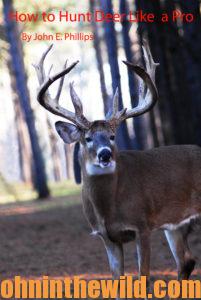 When you click on the books, notice on the left where Amazon says you can read and hear 10% of these books for free. On the right side of the page for each Audible book and below the offer for a free Audible trial, you can click on Buy the Audible book.
When you click on the books, notice on the left where Amazon says you can read and hear 10% of these books for free. On the right side of the page for each Audible book and below the offer for a free Audible trial, you can click on Buy the Audible book.
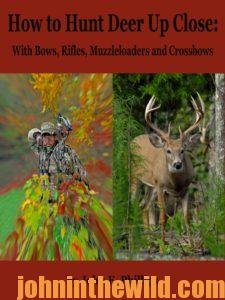 Tomorrow: Construct Hidey Holes to Concentrate Deer
Tomorrow: Construct Hidey Holes to Concentrate Deer


